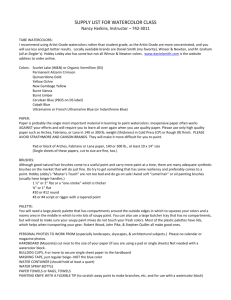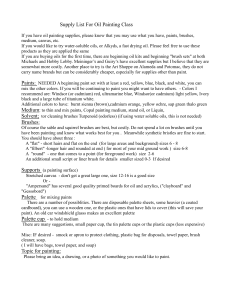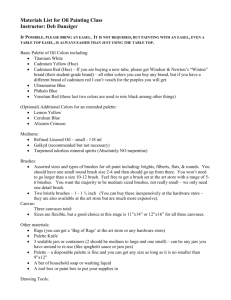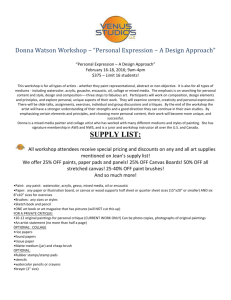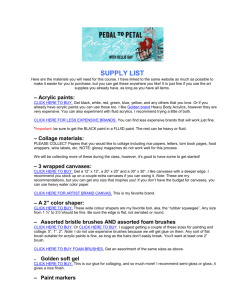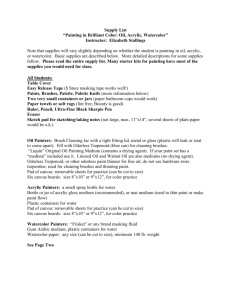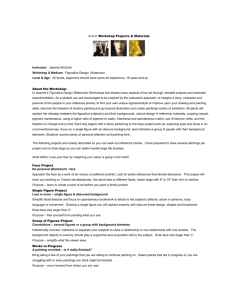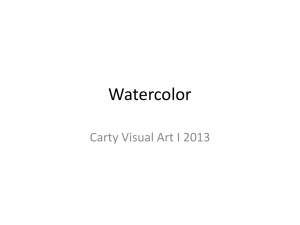The following are great to have, but optional (you can use mine at
advertisement
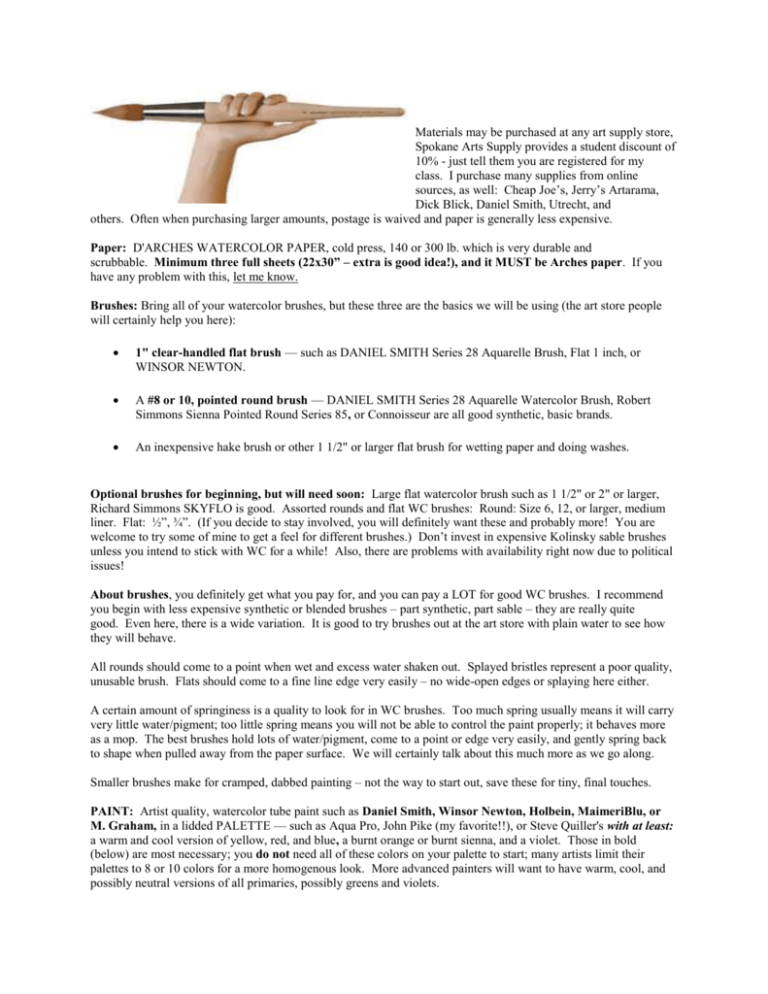
Materials may be purchased at any art supply store, Spokane Arts Supply provides a student discount of 10% - just tell them you are registered for my class. I purchase many supplies from online sources, as well: Cheap Joe’s, Jerry’s Artarama, Dick Blick, Daniel Smith, Utrecht, and others. Often when purchasing larger amounts, postage is waived and paper is generally less expensive. Paper: D'ARCHES WATERCOLOR PAPER, cold press, 140 or 300 lb. which is very durable and scrubbable. Minimum three full sheets (22x30” – extra is good idea!), and it MUST be Arches paper. If you have any problem with this, let me know. Brushes: Bring all of your watercolor brushes, but these three are the basics we will be using (the art store people will certainly help you here): 1" clear-handled flat brush — such as DANIEL SMITH Series 28 Aquarelle Brush, Flat 1 inch, or WINSOR NEWTON. A #8 or 10, pointed round brush — DANIEL SMITH Series 28 Aquarelle Watercolor Brush, Robert Simmons Sienna Pointed Round Series 85, or Connoisseur are all good synthetic, basic brands. An inexpensive hake brush or other 1 1/2" or larger flat brush for wetting paper and doing washes. Optional brushes for beginning, but will need soon: Large flat watercolor brush such as 1 1/2" or 2" or larger, Richard Simmons SKYFLO is good. Assorted rounds and flat WC brushes: Round: Size 6, 12, or larger, medium liner. Flat: ½”, ¾”. (If you decide to stay involved, you will definitely want these and probably more! You are welcome to try some of mine to get a feel for different brushes.) Don’t invest in expensive Kolinsky sable brushes unless you intend to stick with WC for a while! Also, there are problems with availability right now due to political issues! About brushes, you definitely get what you pay for, and you can pay a LOT for good WC brushes. I recommend you begin with less expensive synthetic or blended brushes – part synthetic, part sable – they are really quite good. Even here, there is a wide variation. It is good to try brushes out at the art store with plain water to see how they will behave. All rounds should come to a point when wet and excess water shaken out. Splayed bristles represent a poor quality, unusable brush. Flats should come to a fine line edge very easily – no wide-open edges or splaying here either. A certain amount of springiness is a quality to look for in WC brushes. Too much spring usually means it will carry very little water/pigment; too little spring means you will not be able to control the paint properly; it behaves more as a mop. The best brushes hold lots of water/pigment, come to a point or edge very easily, and gently spring back to shape when pulled away from the paper surface. We will certainly talk about this much more as we go along. Smaller brushes make for cramped, dabbed painting – not the way to start out, save these for tiny, final touches. PAINT: Artist quality, watercolor tube paint such as Daniel Smith, Winsor Newton, Holbein, MaimeriBlu, or M. Graham, in a lidded PALETTE — such as Aqua Pro, John Pike (my favorite!!), or Steve Quiller's with at least: a warm and cool version of yellow, red, and blue, a burnt orange or burnt sienna, and a violet. Those in bold (below) are most necessary; you do not need all of these colors on your palette to start; many artists limit their palettes to 8 or 10 colors for a more homogenous look. More advanced painters will want to have warm, cool, and possibly neutral versions of all primaries, possibly greens and violets. · Raw Umber (warm dark) · Undersea Green (cool dark) · Permanent Sap Green (warm green) · Pthalo Green or Winsor Green (cool greens) · Cerulean Blue · Pthalo Blue or Winsor Blue (Green shade cool, Red shade warmer) · Ultramarine Blue Light (warm blue - Holbein is the best here) · Cobalt Blue (neutral temperature) · Cobalt Teal · Permanent Alizarin Crimson (cool red) · Carbazole Violet (cooler blue violet) or Quinacridone Violet (warmer red violet) - may start with either one or both. · Quinacridone red (neutral temperature) · Quinacridone Coral (warm red-orange) · Permanent rose (neutral temperature red) · Winsor Red or Cadmium Red Medium (warm red) · Quinacridone burnt orange (or burnt sienna) (warm) · Perinone orange · Quinacridone gold · New Gamboge (warm yellow) · Yellow Ochre (warm) · Aureolin or Winsor Lemon (cool yellow) · Green Gold Note: You will not need most browns or blacks to begin with unless you just like to have lots of prepared colors. The paper is the white and we mix luscious darks using three primaries. It is very easy to make MUD with browns, blacks and opaque whites – okay to wait on most of these unless you already have them! (I use raw umber, raw sienna, burnt sienna, and yellow ochre on my permanent palate to develop richer earth tones.) Arrange your paints in a color wheel (i.e. rainbow). Squeeze about 1-2 tsp in your wells at least several days to begin to dry before class - depends on the palette you are using. I don’t fill the wells full, but apply the pigment like thick caulking along the back of its well. You will learn to add a small amount of fresh paint onto your dried paint when you need more pigment available. See the palette photo above to get an idea. It’s nice to NOT have every well filled, as you may want to add a temporary color for a particular project or expand your palette with time. Leave space between the main color families if you have room. I also use a grease pen to write pigment names, etc. – less important as you become more familiar with what you have. If you don’t have one, use mine at class. You may bring your own personal, already-developed palette as long as it has only artist's grade pigments. If you aren’t sure, bring the tubes (do not purchase pan paints, but bring them if that’s what you already have), and we will check them out. I carry my tubes in a large ziplock plastic bag in my kit – for adding more paint to the palette and to get information from the tube when needed. Student quality paint is less expensive, but often has much less pigment – you will not learn to handle paint properly! You will learn about your particular paints, whether they are transparent, sedimentary, staining, liftable, permanency, etc. All of these qualities can become either a plus or a minus depending on your particular project. Dampen one of your new sponges and place it inside the palette with lid closed after the first day of sitting open – it will keep the paints from getting too hard. If you have a palette, but haven’t painted for more than 6 months – knock out the pigment, clean it up, and start over! Some paints don’t rehydrate well. Other necessary materials – use your judgment and make reasonable substitutes (or ask!!) A lightweight support board such as Gator Board, or plywood (3/8”) 17 x 24” (2 inches longer on each dimension for the size paper you intend to work on) to stretch WC paper on. Recommended to have at least two, so 2nd board can be prepared for new project while current project is being continued. We will be using 1/4 and 1/2 sheet WC paper, which is 11"x15" and 15"x22”. All 140 and lighter weight watercolor paper must be stretched for most projects – if you want to work on 300 lb. paper - it doesn’t require stretching – but is much more expensive. Different weights of paper behave differently, so we will experiment with both types in class. Watercolor painters usually work on several paintings at a time, which allows newly painted passages to dry while working on the other piece. Home Depot and Lowe's have precut 2'x4' plywood panels that are much easier to handle than a full sheet. They will cut anything you like, but will charge for each 'chop'. If you purchase a full sheet of plywood, have your plan drawn up for different sizes: 1 full sheet (24"x32"), at least 4 half sheets (17" X 24"), and remaining 1/4 sheets (13"x17") and other sizes such as squares (largest dimension would be 24"x24"). Masking tape – narrow and/or wide, inexpensive, off-white – get at ACE hardware! We will use this for inexpensive masking and maintaining clean edges. Sketchbook, inexpensive drawing paper, tracing paper, and a glue stick. If you purchase a watercolor sketchbook you can paint directly on the pages – much more expensive, though. You will create examples of many kinds of techniques, which you will paste into a small sketchbook with added notes for reference. You can use inexpensive, recipe-card size, bound notebooks for this. Over the years I have filled larger sketchbooks with notes and examples from many classes and workshops – still refer to them! #2H or 2HB pencils (good to pick up a small sharpener for your kit, or use your craft knife) Very sharp, pointed, craft knife (Exacto is what I use) Straight edge ruler Old spoon (used to crease paper for deckle-edged tearing) 2 new, synthetic sponges (small kitchen sink size) Kneaded eraser 2 - pint or quart sized water containers Plastic shower liner (or cut open large garbage bag) to cover table. Roll of Viva or blue shop-grade paper towels (don’t have texture and are very absorbent), some people like to use toilet tissue or Kleenex. Clean, small, water mister bottle – I recycle hair product bottles – clean thoroughly – fill with filtered or softened water if possible as chlorine can affect some paints. PEBEO masking fluid, wooden chopstick, skewer, or old small, paintbrush you don’t value for application. Get a small bottle as it must be thrown out after about 2 years. I also like the small bottles of 'MasquePen' that come with a tiny application tip! You will need the rubber cement square pick-up to remove it – usually next to each other on the store shelf. Wait on this if you’re dabbling with WC – you will probably want this if you stick with it! Clean, old T-shirt or diaper to lay wet brushes on, or a brush holder, or weighted can to put brushes in handle down. Consider a small bamboo rectangle to transport brushes and for temporary storage (rolls up for carrying – take brushes out later so they don’t just rub against the bamboo and wear out more quickly). These are inexpensive and available at all art stores. Choose a Rubbermaid type tub or large bucket with a lid that will hold your materials – large enough for your palette to sit flat and level on the bottom is helpful! There are many ways to transport your stuff. I love my crate on wheels with a lid, which I can set my portfolio on top of for easy dragging. Keep your paper protected in a portfolio, which can be as simple as cardboard taped together to make a large envelope to carry it in. Any bumps, scratches, creases in watercolor paper become problems with holding paint and generally show up as unmanageable scars – WC paper is $$, take care of it! Handle around the edges, and avoid getting skin oils on painting surface – it acts as a ‘resist’ and changes the way the paper accepts the paint. Hairdryer (one or two will be provided) Apron Small color wheel The following are great to have, but optional (you can use mine at class) Shop-style stapler: 1/2 inch staples if working with gator board, 3/8” if working with wood support board. Mr. Clean Magic Eraser – get just the plain with no added chemicals. This can be used to scrub out stubborn areas. White gouache - small tube Small set of watercolor pencils - great for sketching on WC paper as it dissolves and disappears Graphite transfer paper (especially for use on WC paper) Wide, clear, and CHEAP packing tape – doesn’t stick well!
